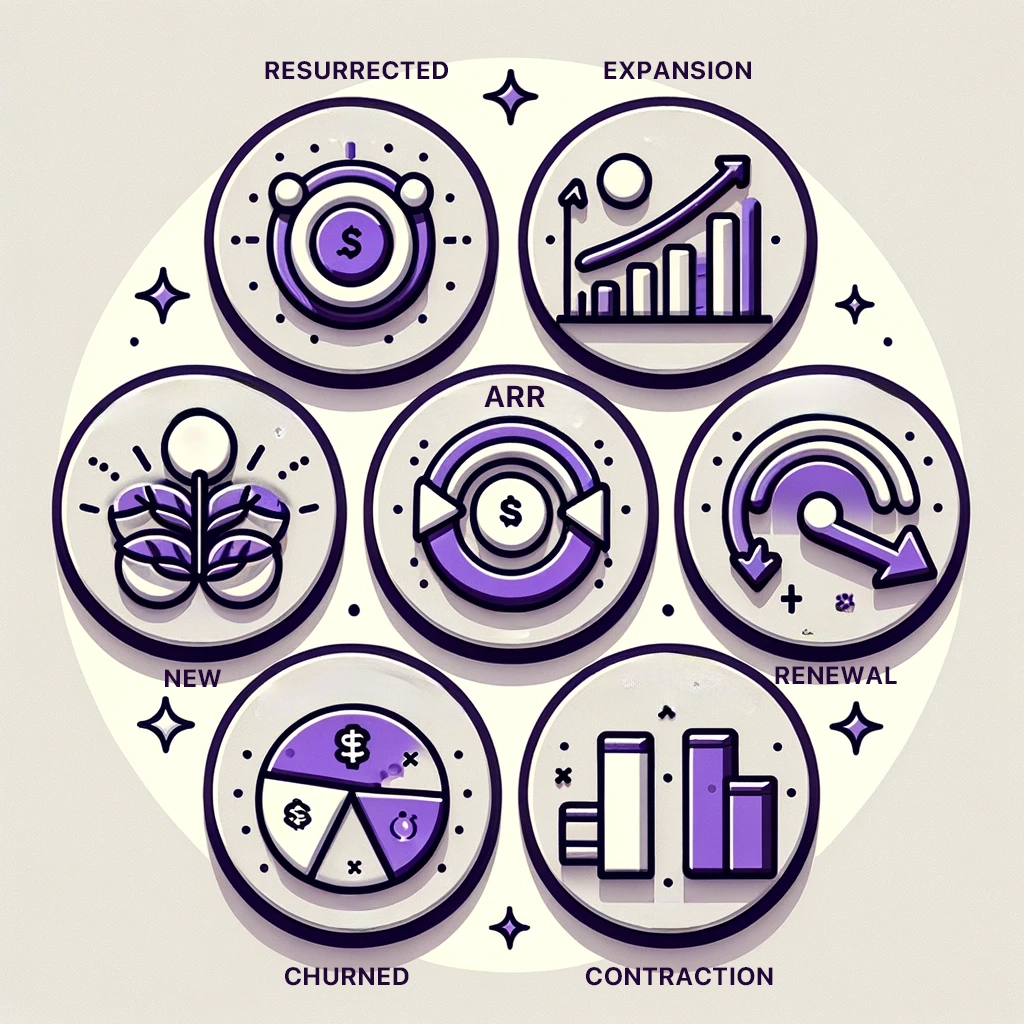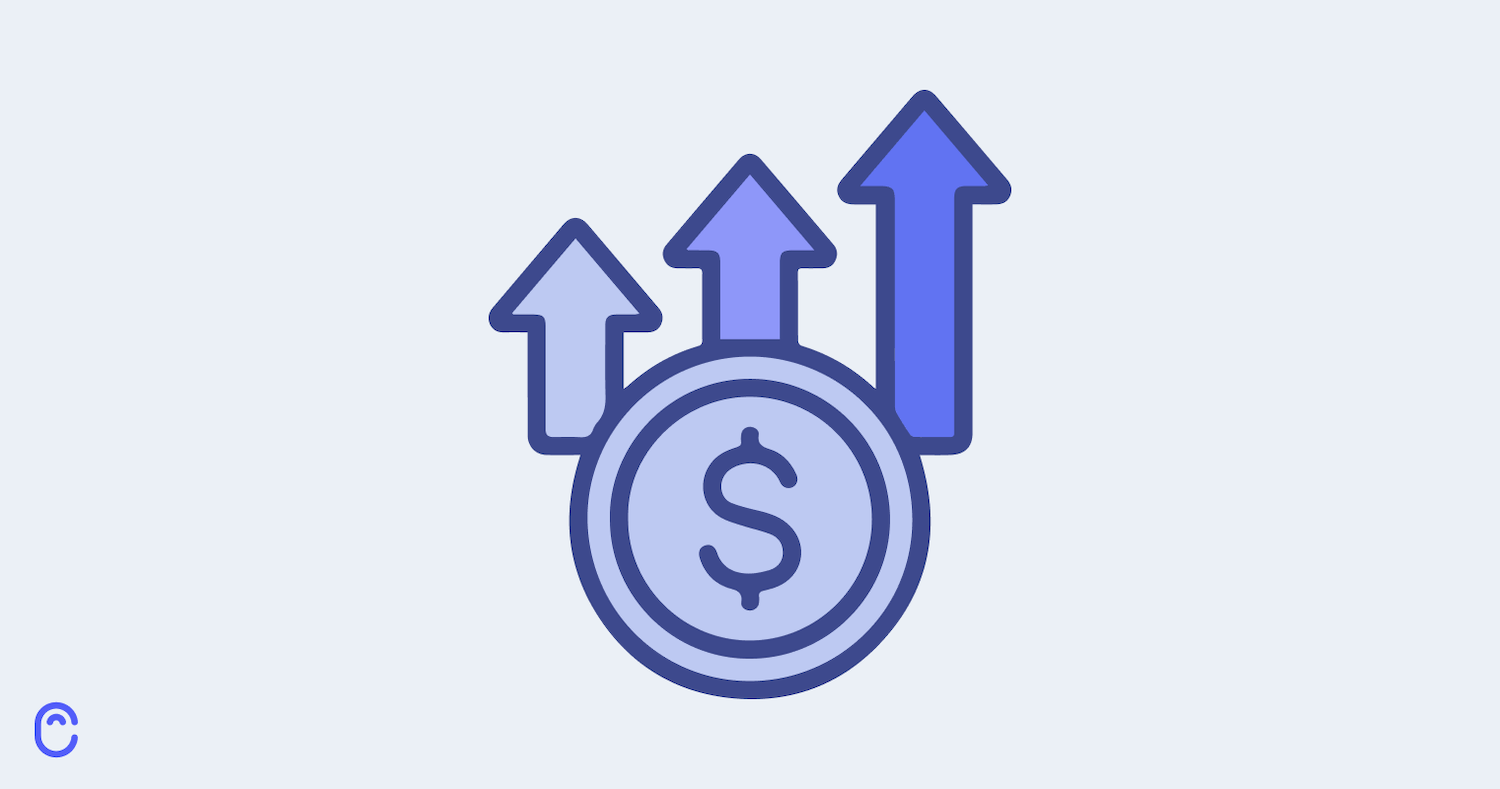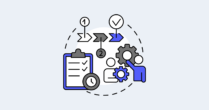Welcome to your guide on Annual Recurring Revenue (ARR) – a crucial metric for any SaaS company. Think of ARR as a straightforward way to understand the steady income your business can expect from subscriptions over a year. It’s the backbone of revenue measurement for subscription-based businesses. It offers a clear view into your company’s financial health, empowering you to make informed and confident decisions.
ARR is a key indicator of performance and growth. A growing ARR suggests a business is successfully acquiring and retaining customers. A declining ARR signals it’s time to reevaluate strategy. ARR offers insights beyond revenue. It can also help you understand customer satisfaction and the effectiveness of your business model.
Let’s explore ARR SaaS metrics more.
ARR vs. other revenue metrics
There are a few ways to measure your revenue. Each has its own advantages and drawbacks.
General revenue
This is everything your business brings in. It counts all kinds of money, not just from subscriptions. It’s good to see the big picture, but it doesn’t tell you much about the steady cash you get monthly or yearly from customers who stick around.
Monthly recurring revenue (MRR)
MRR shows how much money you make monthly from people who subscribe to your service. It helps you see how you’re doing right now. It’s like a quick health check for your business every month.
Annual recurring revenue (ARR)
ARR is about looking ahead. It adds up all the money you expect from subscriptions for the whole year. It helps you plan big things for your business. Want to grow or try something new? ARR helps you see if you can.
Think of it this way:
- MRR is for now. It helps you make fast decisions.
- ARR is for the future. It enables you to plan big moves.
Types of ARR
ARR isn’t just one big number; it’s made up of different parts. Each one tells us something unique about how our business is doing. Let’s use an imaginary startup called CloudTech to illustrate each type of ARR.
| Type of ARR | Description | Example |
| New ARR | From brand new customers who just started subscribing | CloudTech gains 100 new subscriptions at $120 each: $12,000 new ARR. |
| Expansion ARR | When current customers decide they want more from us and upgrade | A customer upgrades, increasing their plan cost by $30/month: $360 expansion ARR. |
| Renewal ARR | Comes from customers who decide to stick with us for another round | A customer renews their $120/year subscription: $120 renewal ARR. |
| Churned ARR | When customers leave and we lose their subscription money | Two customers cancel their $120/year subscriptions: $240 churned ARR. |
| Contraction ARR | When customers decide to scale back a bit and go for a cheaper plan | A customer downgrades, reducing their plan by $5/month: $60 contraction ARR. |
| Resurrected ARR | When customers who had left decide to rejoin. | A former customer re-subscribes at $120/year: $120 resurrected ARR. |
Every type of ARR gives us clues on how to be better.
- New and expansion ARR – show us where we’re growing
- Renewal ARR – says our customers like us enough to stay
- Churned and contraction ARR – point out where we might need to improve
- Resurrected ARR is a sign we’re doing something right again
Together, they help us see the complete picture of our business’s health.

Let’s learn how to calculate ARR.
Calculating ARR
Want to get a clear picture of your company’s financial health? Start with calculating ARR. Here’s a breakdown.
Basic ARR formula
The simplest way to calculate ARR is:
ARR = average annual subscription price per customer × total number of customers

Let’s continue with our example of CloudTech to illustrate again.
Example 1: CloudTech has 100 customers, each paying an annual subscription of $120. The ARR would be:
ARR = $120 × 100 = $12,000
Example 2: Let’s imagine CloudTech has a competitor called SkyVault. It has 50 customers on a $240 annual plan and 50 on a $480 plan. Their ARR calculation would be:
ARR = ($240 × 50) + ($480 × 50) = $12,000 + $24,000 = $36,000
When a SaaS company offers multiple subscription plans or pricing tiers, calculating ARR is more nuanced. Here’s what to consider:
- Average revenue per user (ARPU). If customers are distributed across various plans:
- Calculate the ARPU first: divide total revenue by the total number of customers.
ARPU = total revenue / total number of customers
- Calculate ARR using ARPU: multiply the ARPU by the total number of customers to find the ARR.
ARR = ARPU × total number of customers

- Adjustments for upgrades and downgrades. Include revenue increases from upgrades (expansion ARR) and decreases from downgrades (contraction ARR). This means tracking changes in customer subscriptions throughout the year.
- Pro-rating for mid-year changes. Sometimes, customers upgrade, downgrade, or churn partway through their subscription. Adjust the ARR calculation pro-rata for the time they were on each plan.
You don’t have to calculate it all manually. Several tools can automate and simplify the calculation of ARR.:
- Baremetrics: provides subscription analytics directly from your payment gateway, including ARR calculation.
- ChartMogul: automates your ARR and other critical SaaS metrics.
- Maxio: provides financial management solutions for SaaS businesses.
ARR and financial implications
Annual recurring revenue is not just a measure of income; it profoundly influences critical financial aspects of a SaaS business. Customer acquisition cost (CAC) and overall financial sustainability are essential. Here’s how these elements interplay.
CAC impact
Customer Acquisition Cost (CAC) is what a company spends to acquire a new customer. A high ARR indicates a strong, steady flow of revenue. This can justify higher CAC if the return on investment (ROI) is positive over the customer’s lifecycle. A robust ARR allows businesses to invest confidently in marketing and sales efforts. They’ll know that the subscription revenue (from new and existing customers) can cover these costs and contribute to profitability.
Financial sustainability
ARR predicts financial health. It provides a reliable revenue stream that supports operational and growth activities. Managing the balance between ARR growth and operational costs (including CAC) is crucial for long-term financial sustainability. A steady or increasing ARR suggests the company is on a sustainable path.
Significance of a high ARR-to-CAC ratio for profitability
The ARR-to-CAC ratio is critical for assessing a SaaS company’s efficiency and profitability. A high ratio means that the revenue generated from customers significantly exceeds the cost of acquiring them. This indicates that the company uses resources efficiently and overall has a sound business model.
This ratio also serves as a guide for strategic decisions. For example, you can:
- Allocate marketing budget
- Determine sales strategies
- Plan product development
Companies with a high ARR-to-CAC ratio might choose to aggressively invest in growth.
Do you have a lower ratio? Try the following:
- Reevaluate your customer acquisition strategies
- Increase customer value
- Increase prices
- Add additional services
You need to either increase revenue or decrease CAC.
How to enhance your ARR
Here are strategies that focus on retaining current customers and acquiring new ones.
- Customer retention
- Enhance customer support and engagement. A satisfied customer is more likely to renew and upgrade their subscription
- Implement regular feedback channels to improve the product based on user needs
- Consider loyalty programs or incentives for long-term subscriptions to encourage renewals
- Customer acquisition
- Focus on ROI-positive marketing campaigns
- Use referral programs to leverage existing customers to acquire new ones
- Offer free trials or demos to showcase the value of your product, converting prospects into new subscribers
- Informed decisions
- Use data analytics to understand customer behavior and preferences
- Stay informed about market trends and competitor strategies to adapt and innovate your offerings
- Growing sustainably
- Focus on developing scalable product solutions that can grow with your customers
- Encourage them to upgrade their plans
- Add new features and functionality
- Track other metrics – MRR, CAC, and Customer Lifetime Value (CLTV)
- Regularly monitor Monthly Recurring Revenue (MRR) to get a snapshot of financial health and predict ARR trends.
- Monitor Customer Acquisition Costs (CAC) to ensure that the cost of acquiring new customers doesn’t outweigh the revenue they generate.
- Focus on strategies to maximize Customer Lifetime Value (CLTV). Higher CLTV directly contributes to an increase in ARR and ensures that customers generate more revenue over their lifetime with your company.
Common challenges and solutions
Tracking ARR is pivotal for SaaS companies, but it comes with its own set of challenges. Here’s a look at some common hurdles and how to overcome them, including tools that can help.
Challenge 1: accurately calculating ARR with varied subscription models
Solution: The diversity in subscription plans and pricing tiers can complicate ARR calculation. To tackle this, use a centralized system that automatically updates subscription changes. Make sure it includes upgrades, downgrades, and churns. Tools like Maxio or Zuora specialize in subscription management. They offer robust features for real-time revenue tracking and reporting.
Challenge 2: integrating ARR data across different business functions
Solution: ARR data is not just for the finance team; it’s vital for sales, marketing, and product development. Integrating ARR data across different departments can be challenging without the right tools. Platforms like Salesforce or HubSpot can help. They provide a unified view of customer interactions and financial metrics.
Challenge 3: forecasting future ARR growth
Solution: Predict how ARR will grow and analyze past trends and market conditions. Forecasting tools like Adaptive Planning (from Workday) or Planful can simplify this process. They use historical ARR data and apply predictive analytics to project future revenue growth.
Challenge 4: addressing customer churn
Solution: Customer churn rate directly impacts ARR, so monitoring and addressing it proactively is crucial. Tools like Gainsight or ChurnZero offer comprehensive customer success platforms. They track customer health scores, usage patterns, and feedback.
ARR benchmarks and growth rates
These benchmarks provide a frame of reference for how well your company performs compared to industry standards.
ARR benchmarks vary widely across different sectors within the SaaS industry and depend on a company’s maturity. Early-stage startups often set the first milestone at achieving an ARR of $1 million. This indicates product-market fit and the potential for scalability.
As companies grow, benchmarks evolve. ARR milestones of $10 million, $50 million, and beyond represent company growth and market penetration stages.
For many SaaS companies, the magic number is achieving a growth rate that positions them in the top quartile of their industry segment. For instance, a high-growth SaaS company might aim for an annual growth rate of 40% or more. This indicates strong performance, especially for companies with ARR above $10 million.
Growth rates
The expected growth rate for a SaaS company also depends on its size. Smaller companies (ARR < $10M) are often expected to grow faster (>100% YoY) because they’re starting from a smaller base. Maintaining such high growth rates becomes more challenging as companies scale and increase their ARR. Growth expectations adjust accordingly.
An annual growth rate of 20-30% for mature SaaS companies is generally considered healthy. These companies focus on sustaining growth while expanding their market share and optimizing profitability.
Impact of ARR growth on valuation
ARR growth rate is a critical metric for investors – it signals the company’s future revenue potential and market position. Consistently high growth rates can lead to higher valuations. This attracts more investment and fuels further growth. However, balancing growth with efficient capital use and profitability is essential.
| Metric | Benchmark | Details |
| ARR growth | 68% (under $1M revenue)45% (over $1M revenue) | Growth rates expected for SaaS companies based on their current revenue levels. |
| Burn multiple | Under 1.5 | Measures cash burn against ARR growth, with less than 1X targeted and 1X to 2X being acceptable. |
| Hype factor | Between 1 and 2 | Capital raised divided by ARR, indicating efficiency in converting raised funds to revenue. Over 5 is considered as “hype”. |
| Growth rate (annual) | 60-70% (top quartile)30% (median) | Annual growth rates for SaaS businesses, with the top quartile growing significantly faster. |
| Growth rate (monthly) | 10-17% (early stage, top decile)6-7% (post $3M ARR, top decile) | Monthly growth benchmarks showing how growth rates stabilize as companies mature. |
| Time to $1M ARR | 9 months (best-in-class)2 years 9 months (median) | Timeframes for reaching $1M ARR milestone, highlighting the variance based on company performance. |
| Time to $10M ARR | 2 years 9 months (best-in-class)>5 years (median) | How quickly SaaS companies can reach the $10M ARR mark, with a significant spread between best-in-class and median companies. |
Why ARR is critical and how to measure it right
ARR is vital for any SaaS business. It tells us how much steady income we can expect yearly from subscriptions. This is crucial for planning, making big decisions, and keeping investors interested.
To get ARR SaaS right:
- Be consistent in what you count as ARR
- Update it for any customer changes
- Use good tools to track it
- See how you stack up against others
It helps companies understand their growth, plan for the future, and make smart moves.
In short, ARR isn’t just about the money coming in; it’s about understanding your business’s health and direction.





